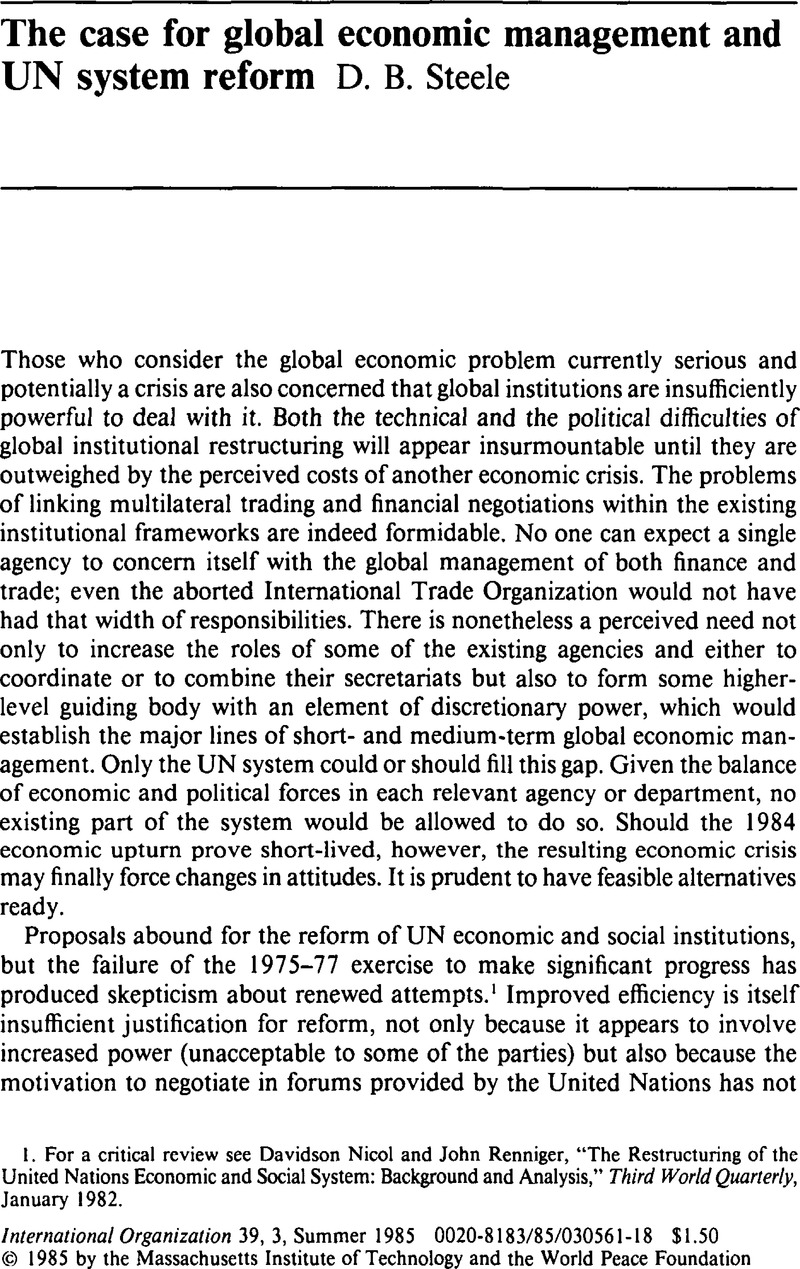No CrossRef data available.
Published online by Cambridge University Press: 22 May 2009

1. For a critical review see Nicol, Davidson and Renniger, John, “The Restructuring of the United Nations Economic and Social System: Background and Analysis,” Third World Quarterly, 01 1982Google Scholar.
2. See Towards a New Bretton Woods: Challenges for the World Financial and Trading System (London: Commonwealth Secretariat, 1983)Google Scholar.
3. This thesis is clearly stated in Robert McNamara's reprinted Barbara Ward Memorial Lecture, in Anne Mattis, ed., SID Prospectus 1982 (Durham: Duke University Press, 1983).
4. Economist, 21–27 July 1984, p. 94.
5. Some South Asian countries with an existing export base or lower debt-service ratios were less vulnerable to the trade recession.
6. “Global economic management” is distinct from “managed trade regimes,” which are bilateral and mainly restrictive.
7. From World Bank data in World Development Report 1983, Figure 3.2.
8. Even with World Bank low-growth case of 2.5% per annum, industrialized countries' GDP would have yielded the developing countries an extra $40 billion. The high-case industrialized countries' growth rate of GDP of 5.0% per annum would have increased 1984 exports in developing countries over actual 1984 by $ 170 billion, perhaps nearly as unacceptably inflationary as the current actual (and to a lesser extent, the World Bank low-case) rates were recessionary.
9. Surveillance under Article IV of the Fund Agreement is no longer to prevent monetary restrictions and multiple currency arrangements but to examine the policies that lie behind exchange rates; IMF Annual Report, 1983, pp. 61–65.
10. See, for example, Rossen, Stein, “Notes on Rules and Mechanisms Governing International Economic Relations” (–Chr. Michelsen Inst., DERAP, 1981)Google Scholar; Stewart, F. and Sengupta, A., International Financial Cooperation: A Framework for Change (Boulder: Westview, 1982)Google Scholar; and Camps, M., Collective Management: The Reform of Global Economic Organizations (New York: McGraw-Hill, 1980)Google Scholar.
11. Any once-and-for-all increase in the issue of new SDRs or their “link” to developing country finance problems has to be considered in terms of the new GEM objective.
12. Miriam Camps in Collective Management clarified the ambiguity in the concept of a global central bank that would preserve a fixed exchange rate, create international reserves, “affect” or “control” money supplies, and, to a greater or lesser extent, conduct countercyclical policy. Not every economist who writes about a global central bank means the same thing.
13. If central banks agreed a fixed ratio between their SDR holdings and other reserves, a small SDR issue could control a large global reserve structure; this is known as the Witteveen Proposal, after the IMF's managing director who put it forward in 1978.
14. IMF Annual Report, 1983, Appendix VIII. SDRs held by participants were 17 billion, still only 5% of total world reserve assets (including gold).
15. Coats, W. R., “The SDR as a Means of Payment: Reply to Comments,” IMF Staff Papers, 09 1983Google Scholar.
16. The Interim Committee was set up to consider and decide on reforms originally prepared by the IMF “Committee of Twenty.” Both the Committee of Twenty and the Executive Board of the IMF were considered by industrialized countries to be too unwieldy and low level, despite weighted voting. For the report of the Committee of Twenty, see IMF, International Monetary Reform (Washington, D.C., 1974)Google Scholar.
17. Camps, Collective Management.
18. Rothstein, R. L., “Is the North-South Dialogue Worth Saving?” Third World Quarterly, 01 1984Google Scholar.
19. Even considering the very great political problems involved, special efforts would be required to ensure further strengthening of the Eastern Bloc (CMEA) countries in the IMF/World Bank Development Committee. Double representation in the forum would achieve the compromise between North and South but not wholly satisfy the required balance between East and West. The Development Committee has more opportunities for flexible membership than the Bank group governing bodies.
20. Preconditions for successful negotiations have been studied by Sewell, J. and Zartman, I. W. in “Global Negotiations: Path to the Future or Dead End Street,” Third World Quarterly 6 (04 1984)CrossRefGoogle Scholar.
21. Finally resulting in the second change to the IMF Articles of Agreement in April 1978.
22. A review of these models is long overdue but requires separate attention and research.
23. The World Bank has both programming and project staff. The first group works with countries on short– and medium–term economic forecasts and analysis of relevant economic and development problems. The programming carried out by countries with the UNDP is to allocate the UNDP's mainly technical cooperation funds.